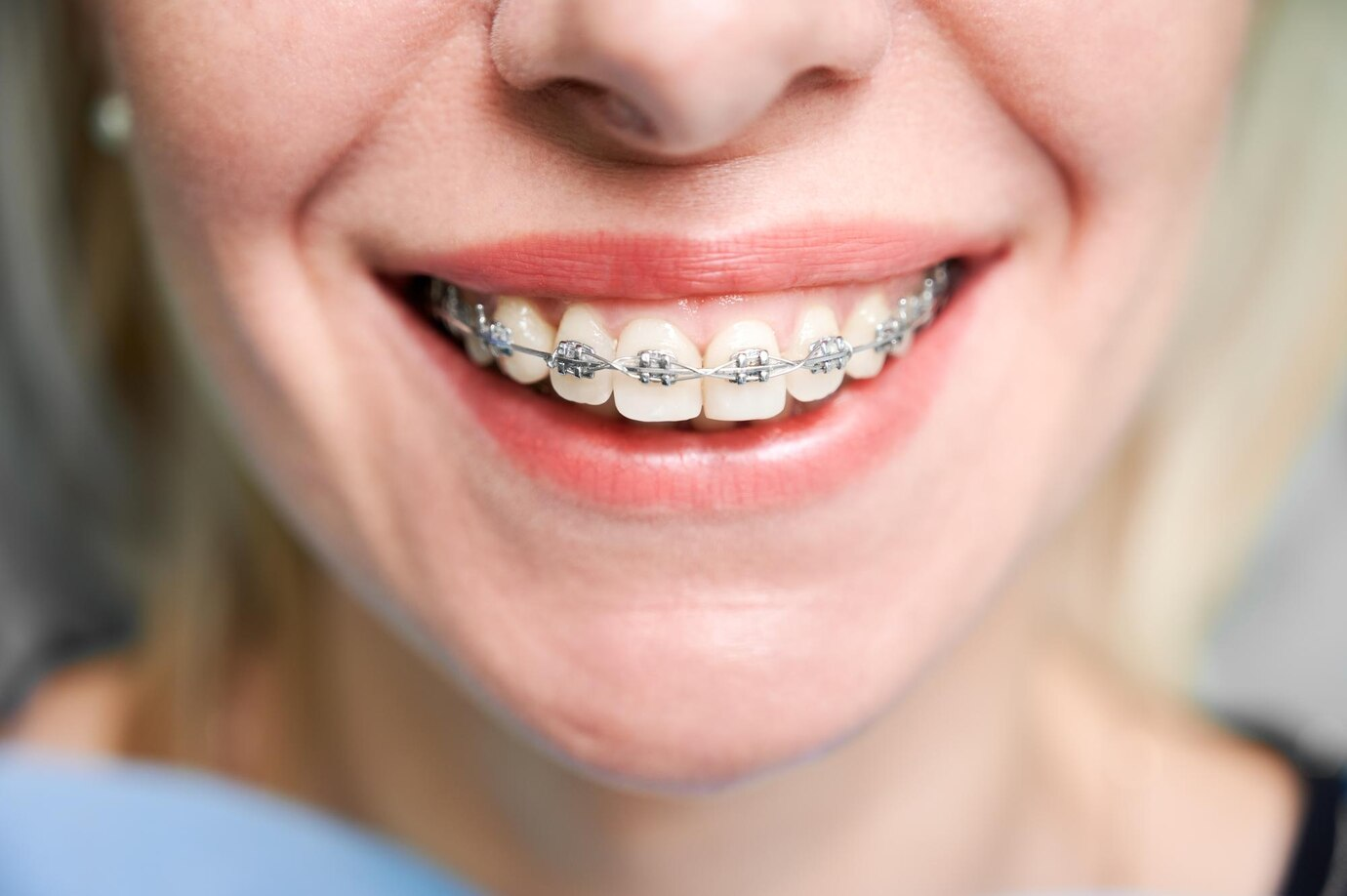Orthodontic braces, a time-tested innovation spanning centuries, offer a universal solution for correcting dental misalignments and transforming lacklustre smiles. This diverse array of braces encompasses the traditional metallic orthodontic framework and modern translucent aligners. By consistently applying pressure to the teeth, they choreograph a gradual realignment, culminating in an aesthetically pleasing, long-lasting reward: a radiant smile.
What Constitutes Teeth Braces?
Teeth braces stand as the fundamental cornerstone in the complex world of orthodontic treatments, combining both aesthetic enhancement and medical restoration. Serving as architects of relentless, orchestrated force, braces methodically guide teeth toward their predetermined positions within the cranial structure.
The framework of braces consists of intricate brackets bonded to each tooth surface, secured with dental adhesive, akin to a skilled artisan’s touch. Connecting this ensemble, an archwire threads through each aligned row, directing a continuous symphony of calculated coercion. The teeth braces cost wires were tightened over time, gradually mending the dental arrangement. Ligatures, much like musical notes in a score, introduce the crescendo of pressure, steering teeth toward their desired equilibrium.
The duration of braces varies depending on the unique characteristics of each case, spanning a timeframe that necessitates regular attention from a dental conductor to navigate the winding path towards a captivating smile.
The Multifaceted Aspects of Teeth Braces
Embarking on a quest to correct dental irregularities, one encounters a spectrum of options, each representing a musical note within the harmonious world of orthodontic possibilities. Here, we explore the diverse dimensions of teeth braces:
Traditional Metal Braces: These iconic, enduring metal braces are celebrated for their widespread use. An array of brackets, attached to each tooth, connected by a sinuous archwire, exerts consistent pressure for alignment. While robust, they may be somewhat conspicuous and less comfortable. Yet, their affordability and speed make them a valuable option.
Ceramic Braces: The chameleons of orthodontics, ceramic braces blend with the dental palette, making them nearly invisible. Similar to their metal counterparts, they guide teeth with subtler notes, requiring fewer adjustments during the alignment journey. However, their porcelain construction makes them vulnerable to fractures and stains, adding an element of delicacy to the orthodontic concerto.
Benefits of Teeth Braces
Teeth braces, with roots dating back to ancient Egypt, serve as masterful architects of smiles, catering to both adults and children. Their primary purpose is to align teeth and improve jaw function, offering a multifaceted range of benefits.
Aesthetic Enhancement: Aligned teeth simplify oral hygiene routines, making brushing and flossing more accessible. This aligned dental ensemble acts as a fortress against dental issues like cavities and gum disease, promoting oral well-being.
Functional Improvement: Beyond aesthetics, brace-induced alignment helps resolve jaw discomfort and temporomandibular disorders, which can be caused by dental misalignments. This practicality extends to maintaining dental hygiene and preventing plaque buildup.

Navigating Risks Associated with Braces
While teeth braces are architects of dental transformation, they come with a mosaic of potential risks. As the orthodontic symphony unfolds, discomfort can punctuate the harmony. Adjustments, the markers of progress, may introduce discomfort and irritation. Speech and chewing may experience some dissonance, but clinicians possess techniques to mitigate these inconveniences.
The interaction between metal and oral structures is not without cost. Gums and cheeks might experience friction-related irritation, leading to the potential for infection or permanent scarring. Dental structures could weaken, making them susceptible to dental issues, emphasizing the need for meticulous oral hygiene throughout the braces’ journey.
The Financial Aspect of an Aligned Symphony
Before embarking on the path of dental transformation, it’s essential to understand the financial aspect. Teeth braces, a symphony in their own right, come with a varied price tag.
Traditional Metal Braces: The cost ranges from $3,000 to $7,000, reflecting the nuances of each dental case.
Ceramic Braces: These aesthetic alternatives range from $4,000 to $8,000, with their porcelain construction requiring fewer adjustments.
Lingual Braces: Concealed behind the teeth, these braces cost approximately $9,000 due to their technical complexity.
Invisalign: The plastic aligners offer a range of $4,500 to $7,200, with the cost varying based on the complexity of dental realignment.
Maintaining the Orthodontic Symphony
To ensure a harmonious dental journey, a regimen of care and maintenance is vital to preserve the integrity of teeth braces. As the dental overture unfolds, here are key steps to keep the symphony unblemished:
Brush Regularly: Use a fluoride-infused toothbrush to clean your teeth twice daily, maintaining a plaque-free sanctuary.
Floss: Utilize dental floss to navigate the spaces between teeth, a vital step in preventing cavities.
Eat Mindfully: Opt for a healthy diet and avoid sugary snacks to protect your teeth against cavities, as braces require extra caution.
In Conclusion
In the grand overture of orthodontic orchestration, teeth braces stand as virtuoso architects of dental restoration. Their symphony, an odyssey blending aesthetics and medical benefits, raises the flag of a lasting, captivating smile. With the meticulous guidance of a dental conductor, braces transcend the boundaries of teeth, rekindling the harmony of dental health. This symphony echoes through the years, a testament to the enduring power of aligned teeth.